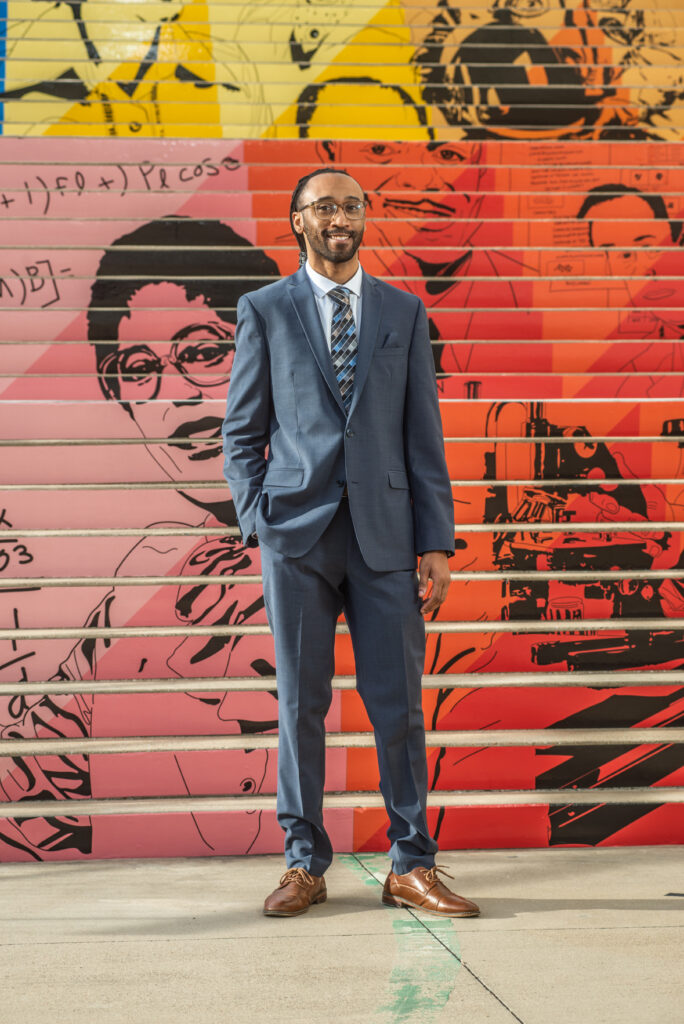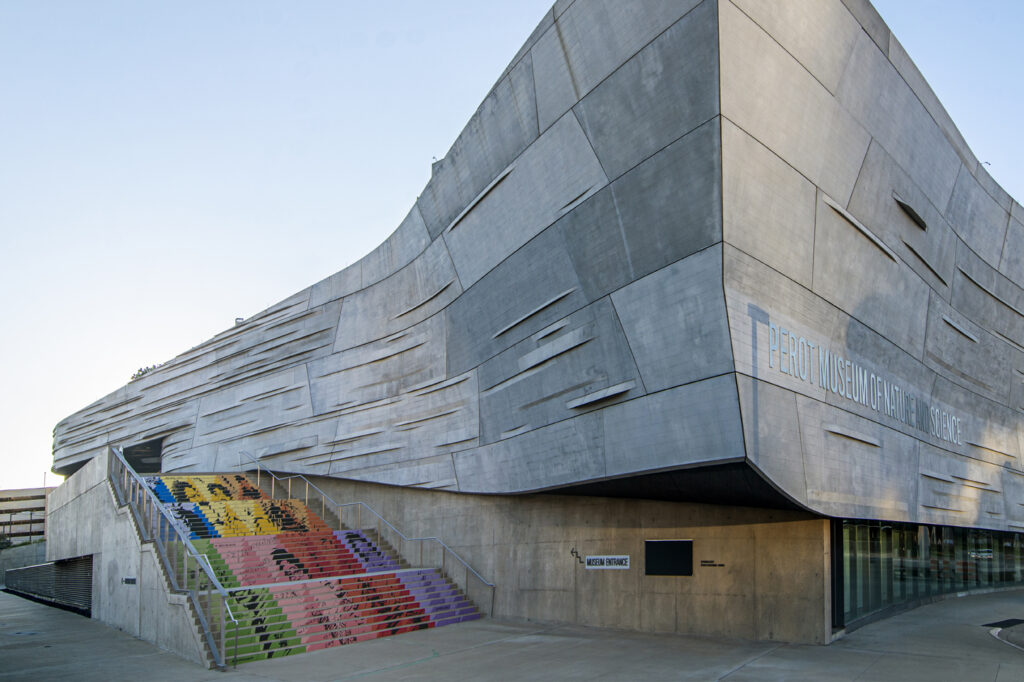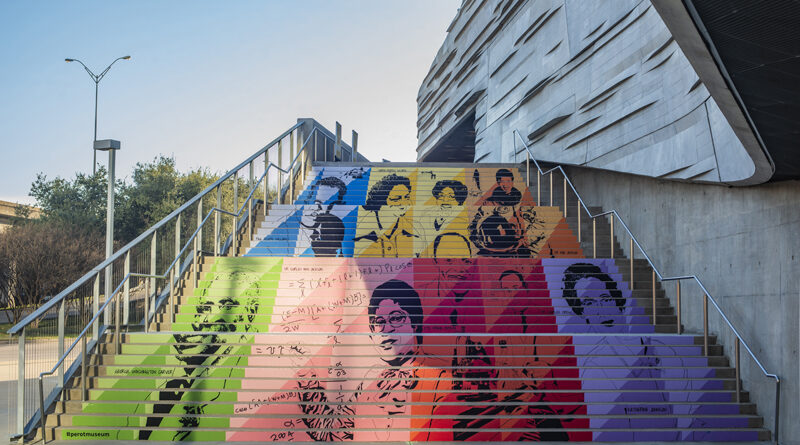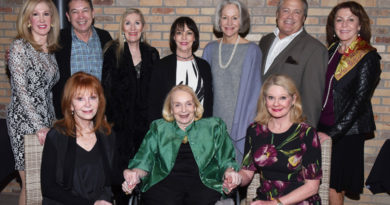Perot Museum And African American Museum, Dallas, Announce Winner Of Staircase Design Project In Celebration Of African American Leaders In Stem
The boldly colored design created by architect and emerging Dallas artist Daniel M. Gunn has been installed on the Museum’s outdoor staircase facing Field Street and will be up through Memorial Day
Calling it a “bold and inspiring tribute to African American leaders who made momentous contributions to science,” the Perot Museum of Nature and Science, in partnership with the African American Museum, Dallas, today announced that local architect and emerging artist Daniel M. Gunn is the winner of the Staircase Project design competition. In addition to a $5,000 prize, Gunn’s larger-than-life image, titled “GIANT STEPS – Celebrating Extraordinary Achievements of African-American Leaders in STEM,” has been installed on the Perot Museum’s multi-story, outdoor staircase facing Field Street. The Staircase Project is presented by Kroger.

“Far too often the important contributions made by African Americans to the advancement of STEM have been untold, unheard and unseen. This magnificent design from Daniel M. Gunn shines a much-needed light on these hidden figures,” said Dr. Linda Silver, Eugene McDermott Chief Executive Officer. ”Giant steps often begin by first taking small steps, so we encourage everyone to climb these stairs and find inspiration for the future through learning about the past.”
Last fall, the Perot Museum and African American Museum conducted a call for entries to create a vibrantly colored, eye-catching design that celebrates African-American leaders in science – from history and modern day – who have made significant contributions to STEM (science, technology, engineering and math). To spotlight the artistic talent in the Dallas/Fort Worth region, the Perot Museum opened the competition to African-American creative designers who reside in North Texas. Entries were judged by a diverse, blue-ribbon panel comprised of regional leaders representing the arts, education and STEM business communities. (See list of panelists below.)

“Our partnership with the Perot Museum has been a great opportunity to link the African American experience to science and to promote African American history and culture,” said Dr. W. Marvin Dulaney, deputy director and chief operating officer of the African American Museum, Dallas. “The design selected for the installation is very eye-catching as well as informative about the African Americans who have contributed to scientific innovation and invention in our country. This has been a very wonderful project that I am thankful the Perot Museum has undertaken.”
The creative design – which has been reproduced and professionally installed using weatherproof, vinyl materials – will remain in place through Memorial Day.
Gunn is a 36-year-old architect employed at Oglesby Greene Architects in downtown Dallas. Born in Alabama, he has lived in New Jersey as well as Louisiana, where he graduated with an architecture degree from Louisiana Tech University in 2008. He picked up a pencil at age five and has been drawing and painting ever since. He states that “When I’m not busy designing buildings by day, I’m honing my skills with the paintbrush on canvas by night.”
His design features Dr. Charles Drew, known as the father of the blood bank; telecommunications inventor Shirley Ann Jackson, the first African-American woman to earn an MIT doctorate; Dr. Mae Jemison, physician, engineer and the first African-American woman in space; and Dallas’ Otis Frank Boykin, an engineer, entrepreneur and inventor with approximately 26 patents. Also included are famed agricultural inventor and “Wizard of Tuskegee” George Washington Carver, and NASA’s Katherine Johnson and Mary Winston Jackson (NASA scientists profiled in the movie Hidden Figures).
While Gunn chose to portray past and present African-American leaders in STEM who have accomplished amazing feats in their respective fields, he also featured two less obvious leaders.
“Architects Paul Revere Williams and Norma Merrick Sklarek were two trailblazers who paved the way for me and many other African-American men and women to pursue careers in architecture,” said Gunn. “I was compelled to include these significant figures because African Americans are not very visible in the field of architecture.”
See end of release for Gunn’s bio and artist statement.
“Kroger is proud to partner with the Perot Museum of Nature and Science and the African American Museum for this ground-breaking project, which not only recognizes those in the African American community who have made significant contributions in science, but also highlights the talents of a North Texas African American artist,” said April Martin, Community Relations Manager, Kroger Dallas Division. “As a company, Kroger has made a commitment to foster a culture that empowers everyone to be their true self, inspires collaboration and feeds the human spirit. Supporting this project further solidifies this commitment, as we strive to utilize our resources to substantially and positively impact our community.”
Charged with the challenge of selecting a winner were panelists Dr. Lauren Cross, program coordinator and assistant professor, interdisciplinary art and design studies, College of Visual Art and Design at the University of North Texas; Byron Sanders, president and CEO, Big Thought; and Arthur Simmons, quality systems management, processes & analytics, Texas Instruments. Dulaney and Silver also served on the panel. Entrants were asked to submit an image along with detailed graphic design files, an artist statement and a short bio and photo. Finalists also participated in interviews with the panelists.
Additional information about the African-American STEM giants depicted on the staircase can be found at perotmuseum.org/STEMleaders or by scanning the QR code located next to the staircase.
The Perot Museum is located at 2201 N. Field Street in Dallas, Texas. For details and visitor information, go to perotmuseum.org.
About the Perot Museum of Nature and Science. The top cultural attraction in Dallas/Fort Worth and a Michelin Green Guide three-star destination, the Perot Museum of Nature and Science is a nonprofit educational organization located in the heart of Dallas, Texas. With a mission to inspire minds through nature and science, the Perot Museum delivers exciting, engaging and innovative visitor and outreach experiences through its education, exhibition, and research and collections programming for children, students, teachers, families and life-long learners. The 180,000-square-foot facility in Victory Park opened in December 2012 and is now recognized as the symbolic gateway to the Dallas Arts District. Future scientists, mathematicians and engineers will find inspiration and enlightenment through 11 permanent exhibit halls on five floors of public space; a children’s museum; a state-of-the art traveling exhibition hall; and The Hoglund Foundation Theater. Designed by 2005 Pritzker Architecture Prize Laureate Thom Mayne and his firm Morphosis Architects, the Victory Park museum has been lauded for its artistry and sustainability. To learn more, please visit perotmuseum.org
About the African American Museum, Dallas. The African America Museum, Dallas was founded in 1974 as a part of Bishop College. The Museum has operated independently since 1979. For more than 40 years, the African American Museum has stood as a cultural beacon in Dallas and the Southwestern United States. Located in Dallas’ historic Fair Park, the African American Museum is the only museum in the Southwestern United States devoted to the collection, preservation and display of African American artistic, cultural and historical materials that relate to the African-American experience. The African American Museum incorporates a wide variety of visual art forms and historical documents that portray the African American experience in the United States, Southwest, and Dallas. The Museum has a small, but rich collection of African art, African-American fine art and one of the largest African American folk-art collections in the United States. Learn more at aamdallas.org.
DANIEL M. GUNN – BIO
I am an emerging visual artist and designer originally from Birmingham, Alabama. My ability to draw was discovered at an early age by my teachers and parents. As a kid, I began to enhance my drawing skills by analyzing and studying the techniques of various works of art that I came across. After residing in Birmingham for ten years, I relocated with my family to Fort Dix, New Jersey. My love of art and drawing continued throughout middle school and high school. In 1998 I enrolled in the Art, Advertising, and Design program at Burlington County Institute of Technology in Medford, New Jersey. After living on the east coast for several years, I would eventually discover another interest which was architecture. In 2001, I relocated with my family to central Louisiana. It was a tremendous culture shock to me after living up north for so long. It was during my senior year of high school that I decided to pursue my interest in architecture and would be accepted into the School of Architecture at Louisiana Tech University. While studying architecture, I worked as an intern architect during the summers. In 2008 I received a Bachelor of Architecture from Louisiana Tech University. I currently reside in Dallas, TX and work at an award winning architecture firm located downtown. When I’m not busy designing buildings by day, I am honing my skills with the paintbrush on canvas by night.
DANIEL M. GUNN – ARTIST STATEMENT
Born to create. Inspired to elevate. Creating art has been my passion since I was a child. I picked up a pencil at the age of 5 and have been drawing and painting ever since. As an artist, I tend to absorb everything around me and allow it to manifest in my artwork. Music, people, places, and memories serve as my catalyst to create. My background in architecture and design also plays a pivotal role in some of the work that I create.
The past and present African-American leaders in STEM that I chose to portray in my art submission are George Washington Carver, Shirley Ann Jackson, Dr. Charles Drew, Katherine Johnson, Mae C. Jemison, Otis Boykin, Mary Winston Jackson, Norma Merrick Sklarek, and Paul Revere Williams. All of these leaders have accomplished amazing feats in their respective fields. While contemplating who I wanted to depict in my art submission I decided to shed light on a couple of people who were less obvious – Paul Revere Williams and Norma Merrick Sklarek. Paul Revere Williams was a prominent African-American architect based in Los Angeles, CA, who is known for designing several landmark buildings that helped to shape the city of L.A. including many private residences for celebrities. Norma Merrick Sklarek was the first African-American woman to pass her license exam to officially become an architect in both New York and California. She is also known for co-founding the largest woman-owned architecture firm in the United States back in 1985 and became the first African-American woman to co-found an architectural practice.
These two trailblazers paved the way for me and many other African-American men and women to pursue careers in architecture. I was compelled to include these significant figures in architecture because African-Americans are not very visible in the field of architecture. In fact, only about 2 percent of all the architects in the United States are Black. That number is even smaller for Black women practicing architecture at only 0.4 percent. I know this first hand from having over a decade of experience in the practice of architecture. As a STEM professional and artist, I felt that I had to enter this competition. I’m also a bit of an architecture nerd so the Perot Museum of Nature and Science is one of my favorite buildings in Dallas. I hope that my design will inspire many African-American boys and girls to pursue a career in architecture and other STEM careers someday.
The African American STEM giants profiled in Daniel M. Gunn’s image are as follows:
Paul Revere Williams (Feb. 18, 1894-Jan. 23, 1980): Architect
Norma Merrick Sklarek (April 15, 1926-Feb. 6, 2012): Architect
Mary Winston Jackson (April 9, 1921-Feb. 11, 2005): Mathematician and aerospace engineer
Dr. Mae Jemison (Oct. 17, 1956-present): Engineer, physician, former NASA astronaut
George Washington Carver (1860s-Jan. 5, 1943): Agricultural scientist and inventor
Otis Frank Boykin (Aug. 29, 1920-March 13, 1982): Dallas inventor and engineer
Dr. Charles Drew (June 3, 1904-April 1, 1950): Surgeon and medical researcher
Katherine Johnson (Aug. 26, 1918-Feb. 24, 2020):NASA mathematician




